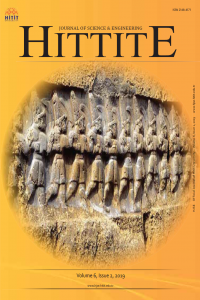Year 2019,
Volume: 6 Issue: 2, 131 - 136, 30.06.2019
Abstract
References
- 1. Castiglia R, Aloise G, Amori G, Annesi F, Bertolino S, Capizzi D, Mori E, Colangelo P, The Italian peninsula hosts a divergent mtDNA lineage of the water vole, Arvicola amphibius s.l., including fossorial and aquatic ecotypes. (2016) 27, doi:10.4404/hystrix-27.2-11588.
- 2. Kryštufek B, Vohralík V. Mammals of Turkey and Cyprus: Rodentia I: Sciuridae, Dipodidae, Gliridae, Arvicolinae. Zgodovinsko društvo za južno Primorsko, Koper.2005
- 3. Miller G.S. Catalogue of the Mammals of Western Europe in the collection of the British Museum. British Museum: (Nat. Hist), London. 1912
- 4. Meylan A, Fossorial Forms of the Water Vole, Arvicola terrestris (L.), in Europe1. EPPO Bulletin 7, 209-218, doi:10.1111/j.1365-2338. (1977) tb02723.x.
- 5. Mursaloğlu B, Türkiye su sıçanlarının, Arvicola, coğrafik varyasyonları. Tübitak V. Bilim Kongresi Tebliğleri, (1975) 353-368.
- 6. Musser GG, Carleton MD, Family Muridae. In: Wilson, D.E., Reeder, D.M. (Eds.), Mammal Species of the World. A Taxonomic and Geographic Reference. The Johns Hopkins University Press, Baltimore. 2005
- 7. Renaud S, Michaux JR, Adaptive latitudinal trends in the mandible shape of Apodemus wood mice. Journal of Biogeography 30, (2003) 1617-1628, doi:10.1046/j.1365- 2699.2003.00932.x.
- 8. Rohlf FJ, Fitting curves to outlines. In: Rohlf FJ, Bookstein FL, eds. The University of Michigan Museum of Zoology. 1990
- 9. Rohlf FJ, Shape statistics: Procrustes superimpositions and tangent spaces. J. Classif 16, (1999) 197–223.
- 10. Rohlf FJ, Tps Series. State University of New York, Stony Brook, Department of Ecology and Evolution. 2004
- 11. Slice DE, Morpheus, Software for Morphometric Research. Department of Biomedical Engineering Wake Forest University School of Medicine, Winston-Salem, NC, USA. 2002
- 12. SPSS, SPSS for Windows, Release 13.0. Standard Version. SPSS Inc., Chicago, IL, USA. 2004
- 13. Steiner H, Vauk G, Saugetiere aus dem Beyşehir Gebiet (vil. Konya, Kleinasien). Zoologischer Anzeiger 176, (1966) 97- 102.
- 14. Zelditch M. L., Swiderski D. L., Sheets H. D. and Fink, W. L. 2004. Geometric morphometrics for biologists: a primer, Elsevier, 443 p.
Year 2019,
Volume: 6 Issue: 2, 131 - 136, 30.06.2019
Abstract
A total of 116 specimens of the genus Arvicola were collected from western part of Turkey Western part of Anatolia and Turkish Thrace and examined based on geometric morphometrics and traditional morphometrics. Morphometrical analyses showed that A. amphibius populations in western part of Turkey are highly differentiated as Anatolian and Thrace populations. Depend on morphometrical differentiation, we conclude that these two populations, classified within two subspecies; Arvicola amphibius persicus and Arvicola amphibius cerncavskii respectively.
References
- 1. Castiglia R, Aloise G, Amori G, Annesi F, Bertolino S, Capizzi D, Mori E, Colangelo P, The Italian peninsula hosts a divergent mtDNA lineage of the water vole, Arvicola amphibius s.l., including fossorial and aquatic ecotypes. (2016) 27, doi:10.4404/hystrix-27.2-11588.
- 2. Kryštufek B, Vohralík V. Mammals of Turkey and Cyprus: Rodentia I: Sciuridae, Dipodidae, Gliridae, Arvicolinae. Zgodovinsko društvo za južno Primorsko, Koper.2005
- 3. Miller G.S. Catalogue of the Mammals of Western Europe in the collection of the British Museum. British Museum: (Nat. Hist), London. 1912
- 4. Meylan A, Fossorial Forms of the Water Vole, Arvicola terrestris (L.), in Europe1. EPPO Bulletin 7, 209-218, doi:10.1111/j.1365-2338. (1977) tb02723.x.
- 5. Mursaloğlu B, Türkiye su sıçanlarının, Arvicola, coğrafik varyasyonları. Tübitak V. Bilim Kongresi Tebliğleri, (1975) 353-368.
- 6. Musser GG, Carleton MD, Family Muridae. In: Wilson, D.E., Reeder, D.M. (Eds.), Mammal Species of the World. A Taxonomic and Geographic Reference. The Johns Hopkins University Press, Baltimore. 2005
- 7. Renaud S, Michaux JR, Adaptive latitudinal trends in the mandible shape of Apodemus wood mice. Journal of Biogeography 30, (2003) 1617-1628, doi:10.1046/j.1365- 2699.2003.00932.x.
- 8. Rohlf FJ, Fitting curves to outlines. In: Rohlf FJ, Bookstein FL, eds. The University of Michigan Museum of Zoology. 1990
- 9. Rohlf FJ, Shape statistics: Procrustes superimpositions and tangent spaces. J. Classif 16, (1999) 197–223.
- 10. Rohlf FJ, Tps Series. State University of New York, Stony Brook, Department of Ecology and Evolution. 2004
- 11. Slice DE, Morpheus, Software for Morphometric Research. Department of Biomedical Engineering Wake Forest University School of Medicine, Winston-Salem, NC, USA. 2002
- 12. SPSS, SPSS for Windows, Release 13.0. Standard Version. SPSS Inc., Chicago, IL, USA. 2004
- 13. Steiner H, Vauk G, Saugetiere aus dem Beyşehir Gebiet (vil. Konya, Kleinasien). Zoologischer Anzeiger 176, (1966) 97- 102.
- 14. Zelditch M. L., Swiderski D. L., Sheets H. D. and Fink, W. L. 2004. Geometric morphometrics for biologists: a primer, Elsevier, 443 p.
There are 14 citations in total.
Details
| Primary Language | English |
|---|---|
| Journal Section | Research Article |
| Authors | |
| Publication Date | June 30, 2019 |
| Published in Issue | Year 2019 Volume: 6 Issue: 2 |
Hittite Journal of Science and Engineering is licensed under a Creative Commons Attribution-NonCommercial 4.0 International License (CC BY NC).


